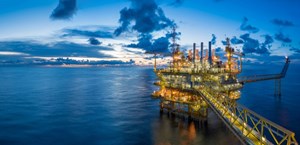“Clock is ticking” for producers looking to exploit oil discoveries in Suriname
(Bloomberg) – Annand Jagesar, the managing director of the state-owned oil company of Suriname, is a man in a hurry.
He’s racing against time, nature and Guyana, the neighboring country that enviably discovered a massive offshore oil field in 2015. Jagesar believes Suriname could have the same bounty, though explorers so far have discovered nowhere near the gushers that have transformed Guyana’s economy and made it a significant non-OPEC source of oil.
“They are in the sweet spot,” Jagesar said in an interview. “The fact we have to work harder will make us stronger.”
Frontier oil exploration in countries like Suriname is raising hopes of an economic windfall for some of the poorest nations on the planet. But if those efforts fall flat, not only will that set back Suriname and other developing economies, such as Namibia and Uruguay, it will also leave the world more reliant on oil from Russia and the Middle East, along with U.S. shale. Already, OPEC’s share of the oil market could rise to as much as 65% by 2050, according to BP’s Energy Outlook.
When TotalEnergies SE and APA Corp. first discovered oil offshore Suriname in 2020, it looked like a continuation of the “Golden Lane,” the name for the area off Guyana that’s now producing 360,000 bpd for a coalition of companies led by Exxon Mobil Corp. — and could surpass 1 million barrels a day by 2027. But it’s taking the French energy giant and its U.S. partner longer than expected to get Suriname’s oil flowing, in part due to disappointing results from an initial group of wells, causing a delay in the target date for oil production by at least two years, to 2027.
Now Jagesar worries that efforts to exploit Suriname’s oil have been too slow – and the clock is ticking. To fend off climate change, the world’s biggest energy consumers are trying to reduce their consumption of fossil fuels as they transition to renewable sources. That could turn Suriname’s oil fields into stranded assets if they aren’t developed fast enough.
Suriname has been counting on the oil money. From 2010 to 2020, the country was led by Desi Bouterse, a convicted murderer and drug trafficker who steered it into a financial crisis and a debt default. (Bouterse is currently appealing a conviction for allegedly killing political opponents decades ago.)
Guyana, meanwhile, has gone from one of Latin America’s poorest countries to the world’s fastest-growing economy, thanks to its oil.
Yet TotalEnergies, Shell Plc and others exploring Suriname’s stretch of the Atlantic Ocean are reluctant to pour too much money into fields that might not have enough oil to justify the steep development costs.
And there’s another problem: Suriname’s oil fields contain large amounts of natural gas and nobody to sell it to. The closest market is in Trinidad 600 miles away. The oil companies don’t want the carbon emissions that flared gas produces, so the fuel will have to be piped to Trinidad, re-injected into the reservoirs or converted toLNG. Each option would involve additional, and costly, investment.
Jagesar is closely monitoring how fast existing exploration contracts are moving along. Chevron Corp., Exxon and Malaysian national oil company Petronas also have paid for the right to drill in specific areas, along with TotalEnergies, APA and Shell. Suriname state-owned oil company Staatsolie has the option to buy up to a 20% stake in any oil field it decides is commercially attractive.
Oil exploration is a risky business with a low rate of success. It can take decades of dry holes to identify the oil-rich sections of an offshore basin, which was the case in Guyana before Exxon’s first discovery. And it’s still a question if the wider Guyana-Suriname basin has commercial potential beyond an area called the Stabroek block, the location of Exxon’s fields, which account for about a third of all discoveries globally since 2015.
“So far the results have been underwhelming outside the Stabroek block,” said Ben Cahill, senior fellow in the Energy Security and Climate Change Program at the Center for Strategic and International Studies in Washington. “There have been a bunch of sub-commercial discoveries.”
TotalEnergies’ latest well, in Block 58, confirmed the existence of an oil field but only half of what’s needed to justify a costly offshore project. The company will drill two or three more wells with APA, but even if they prove successful there isn’t enough time this year to make a final decision on taking the oil field into production, TotalEnergies CEOPatrick Pouyanne said in a Feb. 8 earnings presentation.
Jasegar said he expects Block 58 to eventually come into production with a break-even price of about $25 a barrel, and Staatsolie would exercise its rights for a minority stake in the field.
Shell, which sold a stake it had in Exxon’s Guyana project before oil was discovered, made a non-commercial yet encouraging oil find in Suriname’s waters late last year and is expected to drill more wells, Jagesar said.
Petronas has discovered gas offshore Suriname and is in negotiations to make the project’s terms attractive enough to justify further exploration, said Jagesar. Chevron is also gearing up to drill in a shallow-water block in late 2024.
Jagesar also hopes to find explorers as fast as possible for the rest of Suriname’s offshore acreage. About 12 companies have signed up to study data for deep-water blocks that are currently on offer, and he expects bidding, which concludes on May 31 and will be managed by a Staatsolie subsidiary, to be competitive. Later this year, it will start offering contracts in shallower waters where drilling costs are lower.



